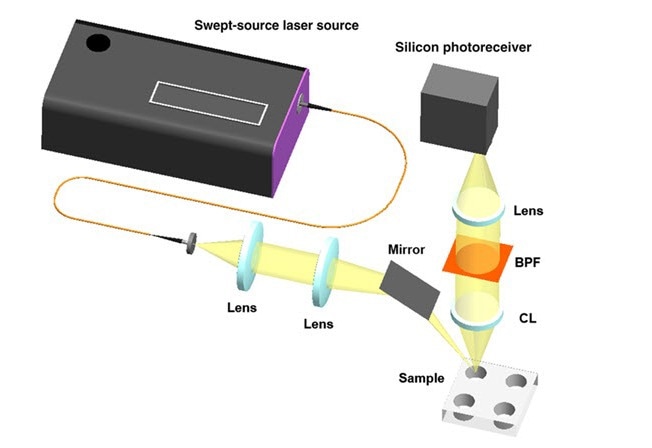Reviewed by Lexie CornerApr 5 2024
In 1928, Indian physicists Sir C. V. Raman and K. S. Krishnan discovered that when light interacts with matter, sections of the scattered light change in energy owing to contact with molecular vibrations, resulting in Raman scattering. The finding set the groundwork for Raman spectroscopy, a method that uses energy changes to generate a unique fingerprint of a material's molecular structure.
 SS-Raman spectroscopy employs a swept-source laser, a narrow-bandwidth bandpass filter (BPF), and a highly sensitive point photoreceiver for sample identification. These components enable the development of cost-effective portable Raman spectrometers. Image Credit: Song et al., doi 10.1117/1.JBO.29.S2.S22703
SS-Raman spectroscopy employs a swept-source laser, a narrow-bandwidth bandpass filter (BPF), and a highly sensitive point photoreceiver for sample identification. These components enable the development of cost-effective portable Raman spectrometers. Image Credit: Song et al., doi 10.1117/1.JBO.29.S2.S22703
Currently, dispersive Raman spectroscopy is the preferred approach for identifying materials in a range of sectors, including material sciences, pharmaceuticals, environmental monitoring, and biomedicine.
However, the spectrometers needed to gather and detect scattered light are bulky, restricting their application outside of laboratory settings. Most portable Raman spectrometers have been designed specifically for chemical analysis.
Researchers from the Korea Advanced Institute of Science and Technology (Republic of Korea) and the Massachusetts Institute of Technology (MIT; United States) created a small swept-source Raman (SS-Raman) spectroscopy system, which was reported in the Journal of Biomedical Optics. Although the concept of SS-Raman was suggested in an earlier patent (US9662047B2), implementation did not occur until recently, owing to a shortage of narrow bandpass filters.
Like traditional dispersive Raman spectroscopy, this technology can detect both chemical and biological materials. The portable device overcomes the constraints of conventional handheld spectrometers and enables sample identification in biomedicine.
Conventional Raman spectroscopy systems employ a fixed-wavelength light source, such as a laser, to excite the sample and cause Raman scattering. In contrast, SS-Raman spectroscopy employs a swept-source laser that produces light at a wide variety of wavelengths. The excitation light is focused on the sample after passing through a short-pass filter, which removes background noise.
A lens collects the scattered light, which is then filtered by a bandpass filter to isolate only the appropriate Raman-shifted wavelength range. The highly sensitive silicon photoreceiver detects the filtered light and turns it into an electrical signal that can be used to analyze the sample.
The proposed SS-Raman setup uses a wavelength swept-source laser (822 to 842 nm), a narrow-bandwidth bandpass filter, and a highly sensitive point photoreceiver for acquiring Raman spectra. These components contribute to the development of compact and cost-effective Raman spectroscopy systems.
Dr. Jeon Woong Kang, Study Corresponding Author and Research Scientist, Massachusetts Institute of Technology
To assess the system’s efficiency, researchers compared Raman spectra from the novel system to those produced from traditional dispersive Raman spectroscopy for a variety of chemical and biological samples. To acquire Raman spectra in the range of 900 to 1200 cm−1, a wide variety of chemicals, including glucose, acetaminophen, hydroxyapatite, and phenylalanine, were investigated as chemical samples.
They examined swine belly slice cross-sections in search of the biological sample. With correlation values ranging from 0.73 to 0.91, the Raman spectra produced from the proposed SS-Raman spectroscopy system closely mirrored those obtained from classical dispersive Raman spectroscopy, suggesting its viability for recognizing both types of samples.
Notably, high-quality filters and light sources are an expensive component of Raman spectroscopy equipment. The SS system had similar issues, with background noise and large peaks in the Raman spectra owing to the bandpass filter.
To keep expenses down, the researchers integrated a signal-processing mechanism into the system. Gaussian filters were utilized to remove ripple noise caused by the unsteady laser output. The Raman spectra’s peaks were sharpened and resolved using a deconvolution approach. Polynomial background reduction was used to reduce background noise caused by the filters’ low optical density.
Overall, the proposed method paves the way for future advances in miniaturizing Raman spectroscopy for chemical and biological investigation. However, there is still potential for development, notably in lowering the sample acquisition time, which now exceeds 40 seconds.
To analyze biological samples in less than a second, the researchers are building a multichannel SS-Raman system with several detectors and bandpass filters. This system should allow for the study of a broader spectrum of molecules in the same amount of time for more diverse applications.
Journal Reference:
Song, J., et al. (2024) Swept-source Raman spectroscopy of chemical and biological materials. Journal of Biomedical Optics. doi:10.1117/1.JBO.29.S2.S22703